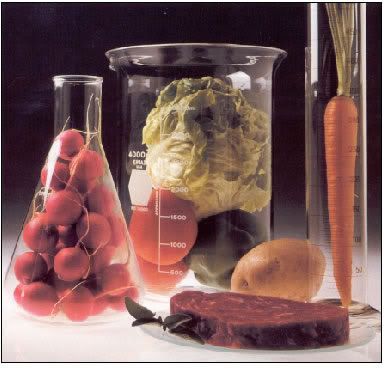Exercise, nutrition and you: an off-campus course for grades 2–12.
MOST CURRENT STUDIES SHOW that student interest in science is declining. Although much new and exciting work is being performed in biomedical areas, little interest is shown in grades 4–12 where basic science is taught. The "high school and beyond" surveys have shown a steady decline in the scientific literacy of students and in the number of students interested in natural science or engineering careers. Likewise, the survey reported that only a small fraction (0.2%) of high school sophomores were projected to receive a PhD in science areas. The 1996 and 1998 National Center for Educational Statistics report showed a continual decline in science and math achievement of eighth and twelfth grade students. Concerns have been raised recently that science learned only from textbooks does not encourage interest in science. That is, memorizing information has not succeeded in enhancing science knowledge and interest; rather a more student-interactive approach is needed. Even so, a textbook-driven curriculum with emphasis on memorization remains the norm. Thus we need to examine how we teach science in grades 4–12.
The recently developed "Healthy People 2010", a PHS-led national activity for setting priority areas for health promotion and disease prevention, has two main goals:
1) increasing the quality and years of healthy life and
2) eliminating health disparities. Although life expectancy has increased greatly over the last decade, males in 25 non-US countries currently have life expectancies greater than those in the United States (73 yr for those born in 1990s) and 17 countries have longer life expectancies for females than do those in the United States (79 yr for those born in 1990s).
Life expectancy and quality of life are both hypothesized to be enhanced by helping people gain knowledge, motivation, and opportunity to live healthier lives. A healthy life disparity occurs due to gender, ethnicity or race, education and/or income, disability, and location. Thus greater knowledge and exposure to healthy aspects of life should enhance these two goals.
The 28 focus areas of Healthy People 2010 include 12 areas directly affected by exercise and/or nutrition: diabetes, arthritis, osteoporosis and chronic back pain, nutrition and overweight, chronic kidney disease, physical activity and fitness disabilities, respiratory diseases, education and community-based programs, cancer, health communications, heart disease and stroke, and injury and violence prevention. According to 1997 information, the four leading causes of death (heart disease, cancer, stroke, and chronic obstructive pulmonary disease) along with diabetes (the seventh leading cause of death) could all be reduced with proper exercise and nutritional practices. We know that performance of regular exercise decreases the incidence of heart disease, colon cancer, high blood pressure, and diabetes, while increasing muscle and bone strength and lean tissue mass. Regular exercise also aids in weight control and is a key part of weight loss through the decrease of fat mass. Performance of regular exercise also enhances psychological well-being. Similarly, proper nutrition can affect these leading causes of death.
The 1996 National Science Education Standards set forth by the National Research Council and followed by individual states and schools sought to address the science deficiencies and enhance the science curriculum. The standards include sections where science, health, exercise, and nutrition content can be merged and applied activities developed. In so doing, the study of the sciences and health can be an integrative and active process, not one where memorization predominates. Rather, an experience of exploring, observing, problem solving, and discussing in an engaging classroom atmosphere takes place. The overall goal of this program was to develop an integrated scientific program for students in grades 2–12 that would enhance and enrich the scientific, mathematic, and health knowledge of the students and their classroom teachers through an interactive and engaging atmosphere.
The park program was taught for 10 days in late spring to more than 500 students representing 18 classes and 10 schools. The most common grade levels in the program were fifth grade and seventh grade (8 of the 18 classes). One second grade class and one advanced placement high school class participated. The teachers who completed the personal information form (4 of the 18 participating) had between 5 and 7 yr of teaching experience. The subjects taught by the teachers were science, social science, and physical education. Schools from the inner city, suburbs, and the surrounding area were all contacted, but the greatest enthusiasm for the program came from schools outside the city (9 of the 10 schools participating). The majority of the students participating were Caucasian, with only a small number of Asian and African-American students.
The teachers and parents were quite capable of running the respiration, cardiovascular system, energy expenditure, and body temperature regulation modules and their comments after the program indicated they enjoyed themselves and learned a bit themselves. The teachers were asked to complete an assessment form several weeks after the program was completed. The questions were grouped into three categories: preliminary contacts, day of program, and reflections on the program. Seven of the eighteen teachers completed the form. The low percentage of written evaluations returned was probably due to the lateness of the program (late spring) in the school year because overall evaluations of the program both verbal (during) and written (afterward) were positive.
For the preliminary contact assessment, teachers were asked about the pre-river handout. All of the teachers thought that the pre-river handout helped to prepare them and their students. Two of the teachers thought the handout was too lengthy and wanted a pre-river handout specific for their grade level. The other five teachers liked the handout, because it was challenging, and they could pick and choose what they needed from several levels. All of the teachers thought doing an activity before the off-campus park program helped the students prepare. The handout would have been more effective, the survey showed, if it had been given to the teachers more than 2 wk before the off-campus park program.
In the section assessing the off-campus park program day itself, teachers were pleased with the organization overall, but would have liked more time for the actual program. When teachers reflected on the program, they were in agreement that the topic of nutrition and exercise was appropriate for their students and that ties to the science curriculum made the program worth using school time. Examples of teachers’ responses to the question "In your perception, what was the educational benefit for your students and yourself?" indicated that the "real world" application of the science was an important aspect of the program. Students were able to see school learning tied into other learning activities. In addition, the teachers received very positive feedback from the parents who had volunteered, possibly encouraging further participation in programs similar to this one.
From the instructors’ perspective, the park program went well. Having five different modules at one time with only two instructors could have been a real problem, but the teachers and parents were oriented by one instructor while the other instructor provided the introduction to the students. For five of the days, a high school student volunteered to help, improving the overall delivery of instruction. The high school student circulated among the groups, making sure that the teachers and parents were comfortable with their roles, and answered questions.
The age range of students did not present a problem for the instructors, because each program was tailored to the abilities of each group of students. Most of the students were in grades five through seven; however, one second grade and one high school class took part in the program.
For the younger grades, the handouts and explanations were simplified. The hands-on activities were successfully completed at all age levels, and only the discussion had to be made age-appropriate. The activities were designed with fifth graders in mind, but were found to be effective for grades fourth through high school without major changes. Except for the cardiovascular module, students had not done any of the activities before the program. The subject matter of exercise and nutrition and its effect on their bodies was personal and interesting to most of the students. Every age group from second graders to high school seniors was interested in their own lung capacity, heart rate, skin temperature, and energy expenditure. The oxygen uptake module, which was interesting for all students, was very useful for the high school students. This module examined energy usage during different intensities of exercise and also allowed for discussion of questions dealing with research, such as those dealing with experimental design, which could be answered through individual demonstrations.
The web site, while mostly written before the start of the park program, still needed updating each day, which became too time intensive for the instructors. The web site was initially meant to be used as an extension of the off-campus/park program, allowing students to participate in the 10-day event. When asked about the use of the web page, teachers either had not accessed the site or had problems accessing the site. A simpler site, with pretraining of the teachers on its use, may have made the site more useful and more worth the time that was spent on it.
Student evaluations of the program were not obtained; therefore, the program may have been improved with the use of pre- and postcompetency tests. We would also have a better measurement of the effectiveness of the program if students and volunteers had performed written evaluations and if we had a better return rate on evaluations from teachers.
In conclusion, from the conversations that occurred during and after the programs with teachers, students, and parent volunteers and from the teachers’ written evaluations, it was apparent that the students gained new insights into how their bodies function and why physical activity is needed to remain healthy. The program complemented and integrated both science and health curricula and was probably most effective at this in the fourth through seventh grades, the level for which the program was initially developed. The park program was a positive program as far as student learning and exposure to life science experiences.




1 Comments:
nike air
jimmy choo
nike free
oakley
louboutin
coach outlet store online
timberland
timberland boots
nike mercurial
michael kors outlet
2018.1.25xukaimin
Post a Comment
<< Home